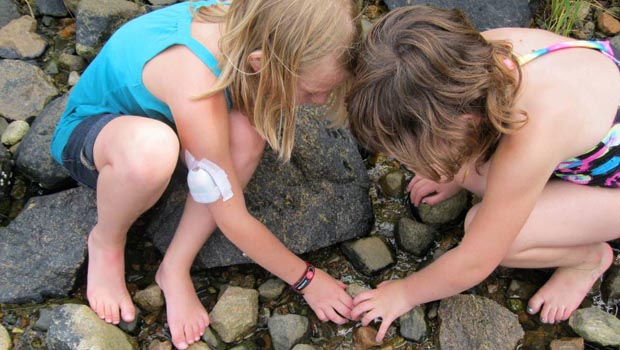Crowdsourcing a T1D Service Dog for Molly

![]() It’s the start of the new school-year on Mount Desert Island, a rural island community connected by a single causeway in Downeast Maine, and the children all come home with stories of the new year school-year.
It’s the start of the new school-year on Mount Desert Island, a rural island community connected by a single causeway in Downeast Maine, and the children all come home with stories of the new year school-year.
10-year-old Molly Dillon, who has Type 1 diabetes, came home with the kind of story that can make the heart of a diabetes parent miss a beat. She told her mother, Heather Dillon, that when she checked her blood sugar levels the meter showed 50. Heather asked Molly if she had felt the low; Molly said she hadn’t. This isn’t an uncommon enough experience, Heather says.
“She’s just great (with her diabetes), but she has a hard time identifying her lows,” Heather says.
So far, options for helping Molly avoid the lows have been limited. She already wears an insulin pump, and so far she has resisted wearing a continuous glucose monitor. Her small frame already has a lot of scar tissue, as she was diagnosed at just 20 months old. Heather, and her husband, Ed, had been searching for a solution when they heard about diabetes service dogs who can sniff out lows before lows become dangerous. They thought it would be a great fit for Molly.
“It’s going to help us as parents, because it will give us peace of mind,” says Heather, a teacher at the island’s high school. “And it allows her a little bit more freedom because it allows her to go places.”
Anecdotally, people with Type 1 diabetes who have service dogs have long hailed them as a great tool for battling lows. Recently a study confirmed those observations, showing that diabetes service dogs did in fact prevent many bouts of hypoglycemia.
But it’s difficult to get insurance to sign on to this form of treatment, and Heather and Ed fretted over the $15,000 cost to train the dog. Luckily, friends and parents of Heather’s students stepped in to convince the Dillons to launch a fundraising campaign.
One of those appreciative parents is Claire Sassner, who is a professional fundraiser. Sassner says it wasn’t easy to convince Heather to raise money for her family, even though Heather raises funds every year to help her students go on trips to Italy and Greece.
“She at first was hesitant to raise the money because it was for personal use,” Sassner says.
But those who knew the Dillons’ story knew the family deserved the help. Molly was born relatively healthy after Heather endured a rough pregnancy. During Molly’s second summer of babyhood, she started not sleeping well and was always cranky. Heather had a relative with Type 1 diabetes, and repeatedly asked the doctor to check for the condition, but they always explained away the symptoms. Then, on the first day of school for Heather, she and her husband insisted on a test. Molly’s blood sugar levels were above 600.
Trying to control the blood sugar levels of a toddler is a Herculean task. The Dillons often spent their time trying to force their child to eat to control lows, or trying to figure out if Molly had had enough to eat to risk an insulin injection. Things smoothed out somewhat when Molly was old enough to be fitted with a pump, but it’s still not easy.
“She generally is in good health,” Ed says. “But illness like stomach flu is no fun. The emergency room is usually what happens.”
Knowing what the Dillons are going through, Sassner and others started organizing a traditional fundraiser, asking supporters to send in checks to the high school. About $1,000 trickled in, a good start but not enough. Sassner says that even if people wanted to help, they often lost momentum to donate because it required the extra steps of writing a check and sending it to the right address.
“Even I dragged my heels sending in a check,” Sassner admitted.
The fundraising organizers retooled their campaign by using a crowdfunding website called GoFundMe. They easily set up a website and advertised it in the community through social media channels. Suddenly, the trickle became a stream, and now the campaign is about halfway to its fundraising goal. Sassner says people are more prone to give when all they have to do is click a mouse three or four times.
“It was just easier,” she says. “It was an incredibly simple site.”
The initial wave of donations has slowed to a trickle again, and the fundraising team is brainstorming other options to get to the finish line, including a restaurant fundraising night or some event that would be a variation on the popular ALS Ice Bucket Challenge.
The clock is ticking, however, as the dog that the Dillons selected is nearly trained to come live with Molly. The trainer has offered to swap out the dog for another dog that will be ready later, but it would delay Molly from having a diabetes service dog by several months. For her part, Heather is now more confident that Molly will be able to have a diabetes service dog; it’s just a matter of time.
To donate to the Molly’s service dog fund, please go to http://www.gofundme.com/d6f77s
Thanks for reading this Insulin Nation article. Want more Type 1 news? Subscribe here.
Have Type 2 diabetes or know someone who does? Try Type 2 Nation, our sister publication.